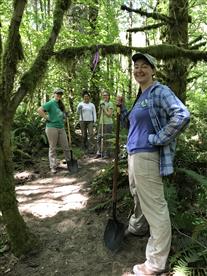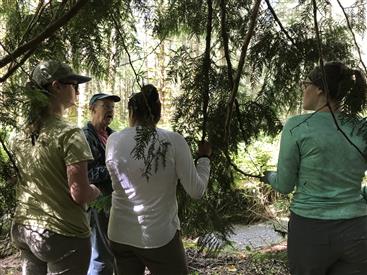The Importance of Paths
by Jim Johnson
No one I know writes better or more thoughtfully about footpaths than Cambridge professor Robert Macfarlane. And now I have one of my own to write about. What follows is a faint and amateurish echo of his marvelous prose. My path (call it a trail, if you prefer) is newly installed at Cumberland Creek. It heads eastward from the bridge paralleling both the creek and the South Skagit Highway, journeying midway between the two, then through a failed Grand Fir plantation, to an oddly rectilinear grove of Western Red Cedar which invariably evokes speculation. Eventually it will lead on through a more conventional stand of sizeable cedars before terminating at the banks of the creek as it spills from under the highway bridge. Macfarlane notes that paths and trails are not arbitrary; they connect things. This path, moving upstream, traces Cumberland Creek from seasonal lowland dawdler at the trailhead to tumbling mountain stream by trail's end.
Over the years I had chosen not to look very closely at this twenty-five acre chunk of the Cumberland Creek Conservation Area. To do so would involve an arduous, maybe unpleasant bushwhack. There were easier paths. Last summer though, Skagit Land Trust Conservation Director Michael Kirshenbaum, Russ Dalton, and I laid out a possible trail. The Trust’s Conservation Assistant, Hannah Williams, and her crew of three young women from TNC’s LEAF program worked on a few hot, buggy August afternoons and created that trail. A subsequent work party that included Dick Reister, Rick Machin, Hal Lee, Pete Hasse, Randy Dills, and Trust staff Regina Wandler and Michael Kirshenbaum built upon and extended the work of Hannah and her crew.


LEAF Crew and Jim working on the new path at Cumberland Creek
A path does several things. For starters it makes the going easier. In so doing this particular path works to make a decaying, vaguely malevolent woods less threatening, and more benign. Fumbling for footing on downed logs masked by luxuriant Sword Ferns, and warding off grasping vines demand one's full attention and puts the focus near to hand. For the walker freed up to listen and look about, the moss covered woodpecker holes acquire a certain beauty as does the sun-dappled shade on the forest floor. The quiet, now observant walker becomes more nearly a part of the forest and reciprocally the forest becomes more nearly a part of her. There are still surprises however. This is a path, not a highway. Each bend of the trail meanders around trees, stumps, and blowdowns, holding out the possibilities of new discovery. A growing sense of familiarity with the landscape breeds not contempt, but regard. For instance, had I known Cumberland Creek only through the window of a car traveling the South Skagit, I wouldn't care nearly as much about it as I do. The farmer essayist Wendell Berry, writing about defending what we love, says "we love what we particularly know." I couldn't agree more.
Many of the paths Cambridge professor Robert Macfarlane walks are ancient, dating back to the Neolithic. Their origins are obscure, but they have a history, however vague, that this newly minted Grand Fir Trail dating all the way back to August of 2017 doesn't. So there is history to be made. Come walk that trail and become a part of history. Just hours after Hannah and her crew packed up their tools deer were walking the trail. Their passing and yours will work to keep the trail open. And while you're walking you might, for a moment, acknowledge the hard work that went into building this modest path.
.JPG&size=500)